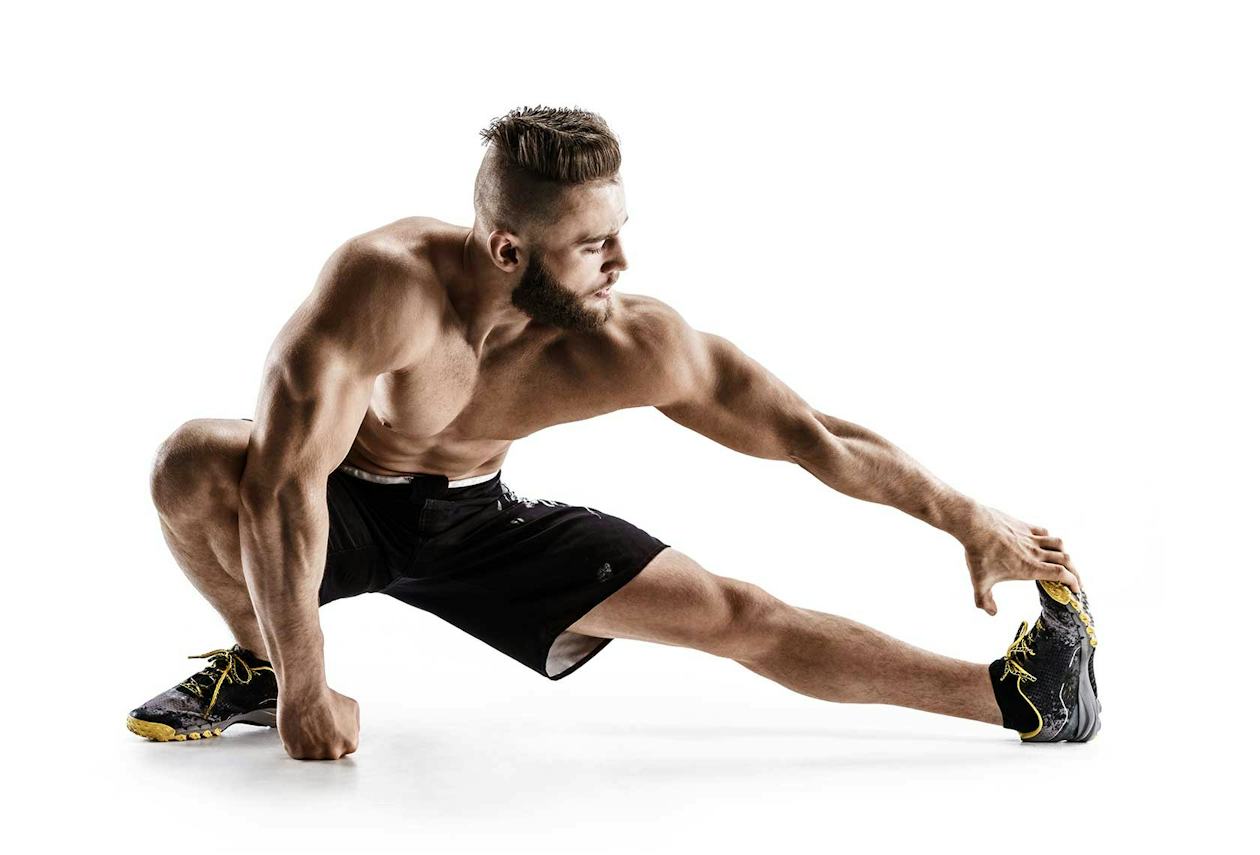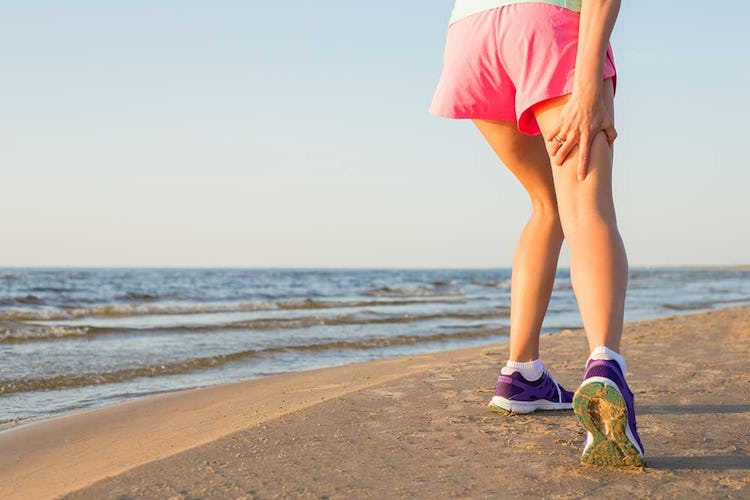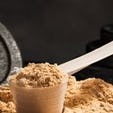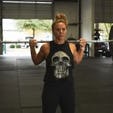If you’re a sports fan, you’ve seen it happen a hundred times. Your favorite player is sprinting down the field, dusting the competition. The crowd is on its feet! He’s about to score, and…
and suddenly he collapses, as if picked off by a sniper at long range, clutching the back of his thigh. The crowd goes quiet. The announcers turn somber. It’s another hamstring tear.
Strengthen Your Hamstrings With These 7 Exercises and 3 Workouts
The hamstrings—a collection of three muscles extending from your sit bones to the backs of your knees—are among the most frequently injured muscles in sports. A study on NFL players reported 1,716 hamstring injuries over a 10-year period, which breaks down to roughly five or six injuries per team, per season. The numbers are similar in pro soccer, basketball, and among regular people in recreational sports (1, 2).
If you’re an athlete, or a weekend warrior who likes to run fast, jump high, and train hard, your hamstrings are at risk. If you’re a desk jockey who spends most of his/her day sitting at a computer, you may be even worse off, especially if you’re planning to get in shape or be more active again. A 2017 study of college students found that 82% of the subjects had tight hamstrings due to prolonged sitting—and these were young adults with a mean age of 20.
Finally, if you’re a gym rat who’s long made the mistake of focusing your leg training on the fronts of your thighs—hitting the hammies as an afterthought—you’ve already lit the fuse that can lead to a hamstring blowout. A study in Isokinetics and Exercise Science showed that imbalances in quad and hamstring strength were associated with non-contact leg injuries.
But don’t worry, we’ve got your back… er, legs. You’re about to get a full tutorial on how to stretch, strengthen, and otherwise bulletproof your hamstrings to prevent injury and improve performance.
How To Strengthen Your Hamstrings
Most muscles work like a winch system: they pull a load toward a fixed point. The top end of your biceps, for example, affixes to the front of your shoulder, giving its lower end a stable point from which to pull. Flex your bi’s, or do a dumbbell curl, and you can see how it works.
The hamstrings, however, are twice as complex. They cross two major joints—the hip and the knee—and shorten at both ends. At the top end, the hamstrings work with your glute muscles to extend your hip (picture the movement of standing up out of a chair). At the lower end—near the back of your knee—the hammies bend your knee joint, pulling your heel up and back. When you use the hamstrings’ two functions at once, such as when you’re sprinting and you drive one leg behind you, they do double duty: the two ends of the muscles pull toward one another, like the ends of a stretched-out exercise band. That’s a lot of tension passing through a single muscle group, and one reason the hamstrings cramp and tear with relative frequency.
Another reason: in our couch-sitting, desk-working world, the glutes—whose primary job is to extend your hips—get overstretched, weak, and, consequently, have a tendency to get lazy. Instead of springing into action when you sprint or jump or go for a max-effort deadlift, they may shirk their duties, forcing the hamstrings to take on a load they weren’t built to handle. Hamstrings picking up the slack for weak glutes is what physical therapists call synergistic dominance: a backup player being forced onto center stage. The rest of us call it an accident waiting to happen.
The remedy: train both major hamstring functions—hip extension and knee flexion—with good form and appropriate loads, and re-train the glutes to do their share of the work.
Pre-Workout Hamstring Stretches
Warm up your hips and hamstrings before any lower-body workout with the following moves, courtesy of Onnit-certified Durability Coach Cristian Plascencia (@cristiangplascencia on Instagram).
Lying L Sit
Step 1: Lie on your back on the floor. Bend your knees and rest your feet close to your butt. Extend your arms by your sides and press your palms into the floor.
Step 2: Tuck your tailbone under slightly so that your pelvis is perpendicular to the floor and your lower back flattens into the floor. Take a deep breath and brace your core.
Step 3: Extend your legs overhead and pull your toes back toward your face. You’ll feel a strong stretch in your hamstrings. Continue to actively pull your toes down and fight to keep your legs straight for 30 seconds. Don’t let your lower back break off the floor. Repeat for 3 total rounds.
Kneeling Half-Mountain Climber Bow Draw
Step 1: Get on all fours with your knees directly under your hips and your hands underneath your shoulders.
Step 2: Step your left foot forward so it lands just outside your left hand. Drive your knee in toward your left arm while pushing your arms apart (left arm toward the left knee, so the two press against each other).
Step 3: Draw your shoulder blades back together and downward. Think: “proud chest.” Tilt your butt up to the ceiling, flattening out your lower back as much as you can, and brace your core. Your body should form a straight line from your head to your tailbone.
Step 4: Begin extending your left knee, pushing your pelvis back toward your right heel. Fight to keep your spine extended and your proud chest position the whole time. Push your foot into the floor so your heel and toes don’t rise up. Finally, bend the knee slowly to come back, and repeat on the opposite side. Perform 5 reps on each side, and repeat for 3 rounds.
Lying Warrior
Step 1: Sit on the floor and spread your legs.
Step 2: Lock out your left leg and twist your torso to the left. Plant your left hand behind your hips and use it to help pull you deeper into the twist. Reach your right arm past your left foot. Allow your right leg to roll inward as it follows you and turn the hip into the ground as much as you can.
Step 3: Plant both your hands on the floor behind your hips and extend your spine, drawing your shoulder blades together and downward—think: “proud chest.”
Step 4: Reverse the movement and repeat on the opposite side. As you repeat for reps, try to twist a little deeper, and even bend forward at the hips and rest on your forearms if you can. Perform 5 reps on each side, and repeat for 3 rounds.
The Best Hamstring Exercises
As mentioned above, a hamstring exercise will require you to either extend your hips or bend your knees—and some of the most effective movements will actually combine both actions, training the glutes as well as the hammies. The following are the best hamstring builders, organized by their primary function.
HIP EXTENSION
In these movements, the hamstrings work with the glutes to push your thigh bones from a flexed position (knee pulled up in front of you) to an extended one (knees moving away from your body). The movement is known as a hinge, and it helps you run faster, jump higher, and maintain a pain-free back. “Most of us can’t get enough hinging,” says Tony Gentilcore, C.S.C.S., owner of Core Fitness in Brookline, MA.
1) Stiff-Legged Deadlift
Step 1: Set a barbell on a rack at about hip level (if you’re very mobile, you can start with the bar on the floor). Grasp the bar with a shoulder-width grip and take it off the rack. Step back and plant your feet hip-width apart. Draw your shoulders back together and downward (think: “proud chest”).
Step 2: Take a deep breath, draw your ribs down, and brace your core. Push your hips backward and, maintaining a long spine from your head to your pelvis, lower your body until you feel a stretch in your hamstrings. Allow your knees to bend only slightly. Actively pull the bar into your body so it stays in contact with your legs the entire time.
Step 3: Squeeze your glutes as you extend your hips and come back up.
The stiff-legged deadlift can also be performed with dumbbells/kettlebells.
2) Back Extension
Step 1: Adjust the pad on the back extension bench so that when you lie on it the top edge lines up with the crease in your hips. Using the handles for support, set up on the bench so your hips rest on the pad and your ankles are braced by the ankle pads and your feet rest against the foot plate about hip-width apart.
Step 2: Turn your toes outward slightly. Interlace your fingers behind your head, spread your elbows wide, and keep them there throughout the movement. Bend at the hips to lower your torso toward the floor, stopping before your lower back rounds. Your head, spine, and pelvis should form a straight line.
Step 3: Take a deep breath into your belly and brace your core. Now squeeze your glutes and hamstrings and extend your hips to raise your torso up until your body forms a straight line from your head to your feet.
If bodyweight alone is too easy for you, add resistance by holding a dumbbell (as shown above).
3) Kettlebell Swing
Step 1: Place a kettlebell on the floor and stand about two feet behind it with feet shoulder-width apart.
Step 2: Draw your shoulder blades together and downward (think: “proud chest”). Draw your ribs down and tuck your tailbone slightly to make your pelvis level with the floor. Brace your abs.
Step 3: Bend your hips backward to lower your torso and grasp the handle of the kettlebell with both hands, overhand.
Step 4: Keeping a long line from your head to your pelvis, and your shoulder blades pressing downward toward your back pockets, shift your weight to your heels. Bend your knees slightly and lift the kettlebell off the floor and hike it back between your legs.
Step 5: When your arms make contact with your inner thighs, forcefully contract your hamstrings and glutes and thrust your hips forward, coming into a standing position and swinging the kettlebell forward and up to about eye level. Allow the kettlebell to swing back between your legs, folding at the hips and bending your knees slightly as the kettlebell swings down and back to begin the next rep.
Do not lift the kettlebell with your upper body, as if performing a front raise shoulder exercise. The swing is an explosive movement and the glutes and hamstrings must perform almost all of the work.
4) Single-Leg Romanian Deadlift
Step 1: Hold a dumbbell in each hand and stand on one leg.
Step 2: Bend your knee slightly. Keeping a long spine and your core braced, drive your hips backward as far as you can, so that your torso lowers toward the floor. Squeeze your glutes to come back up. If you have trouble keeping your balance, you can rest the non-working leg on the floor with your heel raised. Place the toes of that foot right behind the heel of your working foot. Your feet should be hip-width apart.
KNEE FLEXION
These moves (virtually all variations of a machine leg curl) minimize the action at the hip joint while dialing it up at the knee. “I prefer knee flexion isolation moves for beginners and those coming off injury,” says Gentilcore. “There’s more external support so it’s easier to perform and less intimidating.” Isolating a muscle can also help you feel its action more precisely—an essential skill for the novice lifter or athlete.
5) Machine Lying Leg Curl
Step 1: Adjust the ankle pad of the machine so that when you lie down on the support pad your knees will line up with the lever arm’s axis of rotation. Lie facedown on the machine with the backs of your ankles against the ankle pad. If your machine has a support pad that bends upward, position yourself so that your hip joints rest directly over that point.
Step 2: Firmly grasp the machine’s handgrips, lengthening your spine and contracting your lats (the muscles on the sides of your torso). Set your feet so they are parallel and about six inches apart, and flex them hard at the ankles (bend your feet back so your toes are closer to your shins).
Step 3: Keeping your neck and torso long, your hips pressed down into the bench, and your feet parallel throughout the movement, squeeze your hamstrings and slowly bend your knees, drawing the lever arm as close as possible toward your butt.
Step 4: Hold the contracted position for a one-count, squeezing your hamstrings as hard as possible. Slowly reverse the movement, fully straightening your legs at the knees.
HYBRID HIP EXTENSION/KNEE FLEXION
These moves combine the hamstrings’ two functions, making them somewhat more complex than the exercises in the other categories. “Multifaceted movements are great for athletic populations,” says Gentilcore. “They emulate sport and real life to a high degree.” But that doesn’t mean you should skip the other types of hamstring moves, he says, no matter what your goals. “All three categories serve a purpose, and when trained in concert, will likely lead to the best results and more bulletproof hammies.”
6) Glute-Ham Raise
Step 1: Adjust the foot plate of the glute-ham bench back far enough so that when you lie on it the top edge of the pad will line up with the crease in your hips.
Step 2: Using the handles for support, set up on the bench and place your feet on the foot plate, bracing the backs of your ankles against the ankle pads.
Step 3: Set your feet so they are parallel and about hip-width apart. Once your lower body is locked in place, release the handles and extend your hips until your torso is perpendicular to the floor and your knees are bent 90 degrees. This is your starting position.
Step 4: Draw your ribs down and tuck your tailbone under slightly so your pelvis is level. Brace your core. Now lower your body toward the floor under control until it forms a straight line, from head to feet. Your heels will come off the foot plate, and that’s OK. Drive your toes down hard. If that’s too difficult, you can bend slightly at the hips, or use a stick for support (see the Elite Hamstring Workout below).
Step 5: Push your toes into the foot plate and contract your glutes, hamstrings, and calves to pull your body back up to vertical (again, if you need an easier version, keep the bend in your hips). Pause for a moment, and then slowly begin the next rep.
7) Swiss-Ball Leg Curl
Step 1: Lie on your back on the floor with your heels elevated on a medium-sized Swiss ball. Your feet should be about six inches apart and your hands placed beside you on the floor, palms down.
Step 2: Flex your feet, brace your core, and drive your heels into the ball to raise your hips off the floor. Try to keep your neck relaxed, but squeeze your glutes and hamstrings as you bridge up.
Step 3: Bend your knees as in a machine leg curl, rolling the ball toward you. Be sure to keep your core braced so you don’t hyperextend your lower back.
Step 4: Hold the contracted position, squeezing your glutes and hamstrings as hard as possible for a two-count. Then slowly reverse the movement, extending your legs and returning to the starting position.
Best Bodyweight Hamstring Exercises That Can Be Done at Home
If you don’t have a gym membership or are limited to only the most basic equipment (and a little imagination), you can get a great hamstring workout with these exercises.
1) Slider Leg Curl
(See 00:41 in the video above)
This lift is a variation on the Swiss-ball leg curl and uses exercise sliders, but furniture sliders from a hardware store work too, and even paper plates can suffice—if you can train on a waxed or hardwood floor. Ideally, you can perform this move on a smooth surface that won’t create too much friction for the sliders.
Step 1: Lie on your back on the floor. Rest your heels on a pair of sliders and place your hands beside you on the floor, palms down. Set your feet parallel and about six inches apart. Now bend your knees, sliding your feet back close to your butt.
Step 2: Tuck your tailbone under slightly, draw your ribs down, and take a deep breath into your belly. Brace your core. Contract your glutes and hamstrings and press your heels into the sliders, elevating your hips and lower back to full extension. In other words, bridge your hips up. Be sure to keep your core braced to prevent hyperextending your lower back. This is your starting position.
Step 3: Slowly extend your legs, sliding your heels away from you until your butt and legs are just above the floor. When they’re straight, bend your knees and curl the sliders back toward your butt.
If that’s too tough, start by performing only the negative portion of the movement, lowering your body slowly from the bridge position. Take five seconds to straighten your legs, and then rest your butt on the floor if you need to when you reset your legs.
2) Bulgarian Split Squat
(See 01:37 in the video)
Step 1: Stand lunge length in front of a bench, step, or box that’s six to 12 inches high.
Step 2: Step your left foot back and rest the top of your left foot on the bench so that your knee is bent 90 degrees. Your right foot should point straight forward.
Step 3: Hinge your hips back a bit so you feel like you’re leaning forward, but keep your spine straight and tall. Slowly bend your right leg until your left knee is just above the floor. Your front leg should be bent about 90 degrees. Pause, and reverse the movement, squeezing your glutes as you come up.
You can perform the movement with your bodyweight, dumbbells/kettlebells, or a barbell.
3) Dumbbell Stiff-Legged Deadlift
(See 02:34 in the video)
Step 1: Hold a pair of dumbbells at your sides and stand with feet hip-width apart, toes pointing forward. Draw your shoulders back together and downward (think: “proud chest”).
Step 2: Take a deep breath, draw your ribs down, and brace your core. Now push your hips backward and, maintaining a long spine from your head to your pelvis, lower your body until you feel a stretch in your hamstrings. Try to keep your knees nearly straight, but not locked. Your range of motion may not be great, and that’s OK. Go for the stretch, but be safe, and don’t go lower than you feel you have the mobility for. Keep your lower back flat the whole time, and actively pull the weights back to keep them close to your body.
Step 3: Extend your hips and come back up and stand tall.
Put these moves together in this very order for a great hamstring workout, as shown in the video above. At first glance, this routine may not seem like enough work, but consider how you should be performing it. Take each set to within one rep of failure—that is, the point at which your form is about to break down. So if you get 8 reps for an exercise and it’s very hard, to the point where you felt yourself slow down, and you don’t think you can get a ninth rep with good form, STOP the set there. Done in this fashion, the Bulgarian split squats, are very challenging (even at only one set apiece).
1) Slider Leg Curl
Sets: 2 Reps: 6–12
2) Bulgarian Split Squat
Sets: 1 Reps: 8–12 (each leg)
3) Dumbbell Stiff-Legged Deadlift
Sets: 2 Reps: 8–12
Complete Hamstring Workouts
Find the workout that suits your experience level and goals.
Beginner Hamstring Workout
(See 00:55 in the video above)
Just starting out on your quest for unbreakable hamstrings? This is step one: three moves that will blitz the muscles from both ends. Take it easy your first few times in this workout. The moves are entry-level—but if you’re not used to working your hamstrings, they can cramp up when you do too much work too soon. Perform this workout twice a week on nonconsecutive days, either in the same workout that you train your quads and calves, or tacked onto an upper-body day.
1) Back Extension
(See 01:15 in the video)
Sets: 2–3 Reps: 15–20
2) Machine Leg Curl or Banded Leg Curl
(See 01:54 in the video)
Sets: 2–3 Reps: 12–15
If you don’t have access to a lying leg curl machine, use a band around your ankles while you lie on a bench, as shown in the video.
3) Swiss-Ball Leg Curl
(See 02:30 in the video)
Sets: 1–2 Reps: As many as possible with good form
Intermediate Hamstring Workout
(See 03:14 in the video)
Been working out for a while? Below is a leg workout that will give your hamstrings—and the rest of your lower body—a going-over that you might need a few days to recover from. Perform it once or twice a week (do not do any other leg training).
Alternate sets of the paired exercises (marked A and B). So in Superset 1, for example, you’ll perform a set of Bulgarian split squats (one leg and then the other), rest 60–90 seconds, and then a set of slider leg curls. Rest 60–90 seconds, return to the first move, and continue alternating the two moves until you’ve completed three or four sets of each exercise. Then perform the exercises in Superset 2 in the same fashion (do exercise 3 as normal straight sets after you’ve finished all sets for 2A and 2B).
Superset 1:
1A) Bulgarian Split Squat
(See 03:38 in the video)
Sets: 3–4 Reps: 8–12 (each leg)
1B) Slider Leg Curl
(See 04:00 in the video)
Sets: 3–4 Reps: As many reps as possible with good form
Superset 2:
2A) Walking Lunge
(See 04:35 in the video)
Sets: 2–3 Reps: 20–30 (each leg)
2B) Stiff-Legged Deadlift
(See 04:54 in the video)
Sets: 2–3 Reps: 8–10
3) Swiss-Ball Leg Curl
(See 05:37 in the video)
Sets: 2–3 Reps: As many as possible with good form
Elite Hamstring Workout
(See 05:44 in the video)
Feel like your hammies are lagging behind your quads and want to add a little extra work to your leg program? The two mini-workouts below work well as end-of-workout hamstring finishers that you can do after a full-body workout, cardio session, or an upper-body day. You could also add them in on an off day. As in the intermediate workout, alternate sets of each exercise.
Hamstring Finisher Superset #1:
1A) Single-Leg Romanian Deadlift
(See 06:10 in the video)
Sets: 2–3 sets Reps: 8–12 (each leg)
1B) Slider Leg Curl
(See 06:50 in the video)
Sets: 2–3 Reps: As many reps as possible with good form
Hamstring Finisher Superset #2:
2A) Glute-Ham Raise
(See 07:34 in the video)
Sets: 2–3 Reps: 12–15
2B) Kettlebell Swing
(See 08:38 in the video)
Sets: 2–3 sets Reps: 15–20


)





